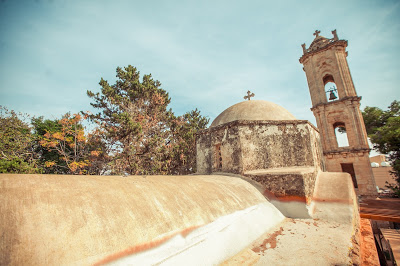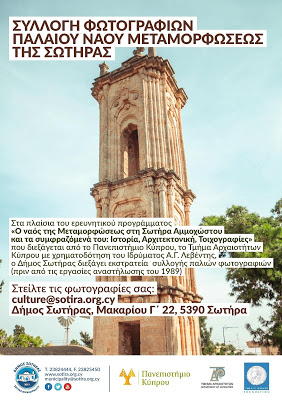In the framework of the research program of the University of Cyprus "The Church of the Transfiguration in Sotira Famagusta and its context: History - Architecture - Murals" which began in June 2014 and is carried out in collaboration with the Department of Antiquities of Cyprus, the Municipality of Sotira conducts old photos. The Municipality of Sotira with its announcement urges those who have old photos (before the restoration of 1989) to send them either by post to the address Municipality of Sotira, 22 Makariou C ', 5390 Sotira, or by e-mail to culture@sotira.org.cy in order to help the research team to complete the very important study for the Savior.
In his statements, the Mayor of Sotiras, Mr. George Takkas, stated that this research program of the University of Cyprus and the Department of Antiquities, which is funded by the AG Foundation. Leventis, is for Sotira the fruits of the many years of efforts of the Municipality of Sotira for the promotion and utilization of the monuments of the cultural heritage. In this context, noted the Mayor Sotiras, was organized last May the very important First Scientific Conference "The Byzantine and Post-Byzantine Savior" with speakers the Byzantine scholar Dr. Christodoulos Hadjichristodoulou, the Art Historian Dr. Maria Paschali, the Historian - Researcher Dr. Nassa Patapiou, and the Curator of Antiquities - Head of the Ephorate of Ancient Monuments Mr. George Filotheou. At the same time, Mayor Sotiras thanked the University of Cyprus, the Department of Antiquities and especially the AG Foundation. Leventis for this important initiative, to conduct research on the history, architecture and frescoes of the old church of the Transfiguration of the Savior, from which, as he said, valuable information has already been extracted, both for the value of the church and the story of the Savior.
The research program
The two-year research program of the University of Cyprus "The Church of the Transfiguration in Sotira Famagusta and its context: History - Architecture - Murals" began in June 2014 and is carried out in collaboration with the Department of Antiquities of Cyprus. The program is implemented with the generous funding of the "Anastasios G. Leventis" Foundation in the context of its wider cooperation with the University of Cyprus to promote research in our country. The support of the Holy Diocese of Constantia - Famagusta and the Municipality of Sotira is extremely helpful in the whole effort. The Community and the Church of the Savior, especially the first elder George Ioannou, embraced the program with great enthusiasm and support the participants at every stage. Their contribution remains valuable.
The church of the Transfiguration in Sotira Famagusta is located inside the old cemetery, in the center of the modern village. The frescoes, which originally adorned the interior of the single-aisled, vaulted church, are now preserved in fragments, mainly in the pilasters and the undergarments of the arches that bear the dome. Based on their style, they date to the last decades of the 13th century. AD, a particularly interesting and fruitful period for the development of Cypriot ecclesiastical painting, but about which we know very little due to the minimal number of published murals offered for study. The need to fill this important research gap led to the undertaking of this program. From its conception, however, it was considered appropriate not only to study the murals, but to proceed to a comprehensive study of the monument, which includes both its interesting architecture and its historical and social contexts.
The deliverable of the program is the publication of a collective scientific volume in English by an international scientific publishing house, which will include chapters on the history of the Savior and its area during the Byzantine period and the Latin period, the architecture and the frescoes of the church of the Transfiguration and the results of the technical analyzes of the murals. The iconostasis of the church will also be studied, which, although dating to the 19th century, also includes wood-carved elements dating to the 16th century.
An international scientific team is working to achieve the research objectives of the program, in which the following participate (alphabetically):
- Andreas Zisimos, Department of Geological Survey of Cyprus
- Stella Frigerio-Zeniou, Switzerland
- Mat Immerzeel, Leiden University, The Netherlands
- Ioanna Kakoulli, University of California, Los Angeles, USA
- Athanasios Papageorgiou, former Director of the Department of Antiquities of Cyprus
- Tassos Papakostas, King's College London, Britain
- Maria Parani, University of Cyprus (program coordinator)
- Maria Paschali, Nicosia
- Philippe Trélat, History Research Group of the University of Rouen, France
- George Filotheou, Curator of Monuments, Department of Antiquities of Cyprus (coordinator of the program)
The architectural imprint of the church has been undertaken by the architectural office Between the Lines (David Castrillo, Maria Kosti, Thomas Kostis), while the photographic imprint of the monument was taken by the photographer of the Cyprus Department of Antiquities, Thanassis Athanassiou.
With the start of the project and the first visit of the team to the monument for an on-site study in July 2014, it was found that there was a serious moisture problem, which threatened the murals. The Department of Antiquities immediately proceeded to carry out drainage works around the temple. During these works, architectural remains came to light, which reveal that the church of the Transfiguration was built on the ruins of a larger earlier early Byzantine basilica. The work of the Department of Antiquities continues, while these new findings will be taken into account in the discussion of the architecture of the monument.
In terms of painting decoration, at least four layers of murals have been identified. The program focuses on the second layer, which dates back to the last decades of the 13th century. Despite the fragmentary state of preservation of the murals, the surviving sections reveal the peculiar character of the iconographic program, both in terms of its content and its layout in the space. From an iconographic point of view, the imposing fresco on the north wall of two equestrian saints, accompanied by the portrait of an anonymous donor, and the inclusion in the iconographic program of a number of Cypriot saints, including the local St. Constantine of Ormidia. In general, although one can easily identify continuations with the domestic local Byzantine tradition both in terms of iconography and style, there are elements that suggest contacts with the artistic traditions of the Christian communities of the East, and in fact of Lebanon and Syria.
The study and publication of the church of the Transfiguration in Sotira and in fact of its extremely important frescoes aspires to make this relatively unknown monument better known to the local and international scientific community. The ultimate goal is the fruitful contribution to the understanding of artistic production in Cyprus during the 13th century through the investigation of the dynamic encounter in Sotira of a living local Byzantine tradition with the Christian art of the Crusades.
Source: Municipality of Sotiras / University of Cyprus / Department of Antiquities of Cyprus


